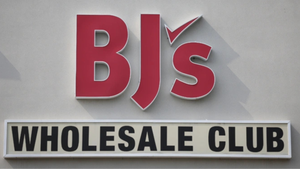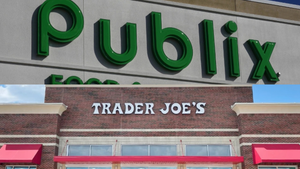Target sees Q1 sales rise as earnings fallTarget sees Q1 sales rise as earnings fall
CEO Brian Cornell cites ‘more dramatic change in our sales mix than we anticipated’
May 18, 2022

Target Corp. eked out fiscal 2022 first-quarter sales gains atop robust growth a year ago but fell well short of Wall Street’s earnings estimates as higher costs and inventory issues bit into profits.
Minneapolis-based Target said Wednesday that net sales for the quarter ended May 1 came in at $24.83 billion, up 4% from $23.88 billion a year earlier, when the company saw a 23.3% jump. Overall revenue also rose 4%, to $25.17 billion.
Comparable sales in the 2022 first quarter increased 3.3% year over year, as Target generated 3.9% growth in transactions but reported a 0.6% dip in the average ticket size. That compared with a 22.9% comp-sales surge in the 2021 quarter, which saw the transaction count rise 17.1% and average ticket grow 5%.
“As expected, our business continued to grow in the first quarter, on top of huge gains a year ago, underlying the resilience of both the consumer and the ability of our team to serve them. However, through a host of factors, this growth was challenged by a mutually high cost, resulting in profitability well below where we expected to be and where we expect to operate over time,” Target Chairman and CEO Brian Cornell told analysts in a conference call on Wednesday.
“First-quarter comparable sales grew by 3.3% on top of 23% growth a year ago. This marked our 20th consecutive quarter of comparable sales increases. Eleven of those quarters were before the pandemic, followed by the rapid acceleration we saw in 2020. We’re also encouraged that traffic continues to fuel our growth increasing nearly 4% in the quarter on top of 17% growth a year ago,” he explained. “Our first-quarter gross margin rate was well below our expectations, reflecting a combination of factors that prove to be very different than expected, driven by a rapidly shifting macro backdrop and changing consumer behavior.”

"Through a host of factors, this growth was challenged by a mutually high cost, resulting in profitability well below where we expected to be." — Brian Cornell, Target chairman & CEO
At the bottom line, Target post 2022 first-quarter net income of nearly $1.01 billion, or $2.16 per diluted share, compared with $2.1 billion, or $4.17 per diluted share, a year earlier. Adjusted net earnings per share were $2.19 in the 2022 quarter (excluding a 3-cents-per-share charge from depreciation and amortization) versus $3.69 in the 2021 quarter (excluding a 53-cents-per-share gain on the sale of Dermstore and asset impairment charges of 6 cents per share), Target reported.
Analysts, on average, had forecast Q1 2022 adjusted EPS of $3.06, with estimates ranging from $2.55 to $3.66, according to Refinitiv.
“More specifically, we saw much-higher-than-expected freight and transportation costs and a more dramatic change in our sales mix than we anticipated. This resulted in excess inventory, much of it in categories which put additional strain on our already-stressed supply chain,” Cornell said. “While we have a lot of work ahead of us to restore profitability to a level where we expect to operate over time, I want to thank the team for maintaining their laser focus on the guest experience.”

Target tallied strong sales growth in the food and beverage, household staples and beauty categories during the first quarter.
During the first quarter, Target continued to see strong growth in the food and beverage, household essentials and beauty categories, but the retailer experienced “a rapid slowdown” in the year-over-year sales trends for the apparel, home and hardlines segments starting in March, when it began to see the impact of last year’s stimulus payments, according to Cornell.
“While we anticipated a post-stimulus slowdown in these categories, and we expect the consumer to continue refocusing their spending away from goods and services, we didn’t anticipate the magnitude of that shift,” he said in the call. “This led us to carry too much inventory, particularly in bulky categories including kitchen appliances, TVs and outdoor furniture. And with very little slack capacity after two years of unprecedented growth, we faced elevated costs-to-store and began rightsizing our inventory position.”
Still, Target continued to generate omnichannel growth in the 2022 first quarter. Digital comp sales rose 3.2%, atop a 50.2% gain in the 2021 quarter, while comp-store sales increased 3.4%, building on 18% growth a year earlier.
More than 95% of first-quarter sales were fulfilled by stores, Target said. Sales via same-day services — Order Pickup (in-store pickup), Drive Up (curbside pickup) and Shipt (on-demand delivery) — climbed 8% year over year, fueled mainly by Drive Up, which tallied mid-teens growth atop a more than 120% gain a year ago.
“Among our sales channels, first-quarter comps were balanced between store and digital, as each increased over more than 3%. Within our digital channel, growth continued to be led by our same-day services Drive Up and Order Pickup,” Cornell said. “Since Q1 of 2019, prior to the pandemic, first-quarter sales have grown more than 40%, or just over $7.4 billion. Broken down by channel, store sales accounted for about $4.1 billion of this increase, while digital sales drove another $3.3 billion and expanded by more than 260% over that time.”

New store openings have focused on small formats, such as the 30,000-square-foot location that Target opened in Manhattan's Times Square last month.
For 2022, Target plans to remodel nearly 400 stores, and almost half of those projects were under way through the end of the first quarter, Chief Operating Officer John Mulligan told analysts in the call.
“Just under 200 of this year’s projects will be traditional full remodels, in which we transform every part of the store, from wall-to-wall and floor-to-ceiling, updating the shopping experience to make it more inspiring for our guests and more efficient for our team to operate,” Mulligan said.
This year, Target also expects to complete more than 200 fulfillment remodels, which focus on store operations and support of same-day services.
“These projects make changes within the four walls of the store to add capacity for same-day orders and incorporate features to enhance our [Order] Pickup and Drive Up capabilities,” Mulligan explained. “When warranted these remodels include the addition of walk-in coolers and freezers near the front of the store, adding reliable capacity for our team to fulfill fresh, refrigerated and frozen items through our Pickup and Drive Up services. In addition, with many of these projects, we had a dedicated store door for our team members to use when delivering Drive Up orders to the parking lot. We’re also adding canopies, more prominent signage and Drive Up spaces in our parking lots, making the Drive Up process safer and easier for both our team members and guests.”
Target closed out the first quarter with 1,933 stores overall, up from 1,909 a year earlier. Over the past year, the retailer added one store of 170,000 square feet or more, nine stores between 50,000 and 169,999 square feet, and 14 stores of 49,999 square feet or less.
“We continue to open new stores around the country,” Mulligan said. “In the first quarter, we opened seven locations — all smaller formats — in markets ranging from Jackson Hole in Wyoming to Times Square in New York. We continue to be pleased with the performance of our new stores and their ability to flexibly serve guests in new neighborhoods.”
Read more about:
TargetAbout the Author
You May Also Like






